
Authors: Ribeiro A, Veiga F, Santos D, Torres-Labandeira JJ, Concheiro A, Alvarez-Lorenzo C
Article Title: Receptor-based biomimetic NVP/DMA contact lenses for loading/eluting carbonic anhydrase inhibitors.
Publication date: 2011
Journal: Journal of Membrane Science
Volume: 383
Issue: (1-2)
Page numbers: 60-69.
DOI: 10.1016/j.memsci.2011.08.030
Alternative URL: http://www.sciencedirect.com/science/article/pii/S0376738811006077
Abstract: Biomimetic principles were applied to design N,N-dimethylacrylamide (DMA) and N-vinylpyrrolidone (NVP) hydrogels with enhanced affinity for the antiglaucoma drugs acetazolamide (ACT) and ethoxzolamide (ETOX). These inhibitors of carbonic anhydrase are orally given to decrease intraocular pressure, but their systemic side effects prompt the development of devices for ocular delivery. Receptors for ACT and ETOX were created in the hydrogels by mimicking the active site of the metallo-enzyme, using 1- or 4-vinylimidazole (1VI or 4VI) and N-hydroxyethyl acrylamide (HEAA) as functional monomers. To some hydrogels, zinc salt and ACT (imprinted networks) were incorporated before polymerization for a closer mimicking of the natural receptor. Viscoelasticity, water uptake, light transmissibility, cytocompatibility, zinc content, and drug loading and release were evaluated. 4VI retained the non-polymerizable zinc salt better than 1VI and rendered visible light transparent hydrogels. NVP-co-DMA hydrogels bearing 4VI, HEAA and Zn2+ showed 2-fold increase in drug affinity (estimated as network/water partition coefficient) and more sustained delivery. ACT-imprinted networks achieved the highest loading and controlled ACT release for 9 h. ETOX release was sustained for more than one week. Favorable physicochemical, mechanical and cytocompatibility features suggest that receptor-inspired hydrogels are promising candidates for the development of biomimetic medicated soft contact lenses as well as other delivery systems
Template and target information: acetazolamide, ACT, ethoxzolamide, ETOX
Author keywords: Bioinspired drug delivery, CAI, molecular imprinting, Combination product, Soft contact lens



Join the Society for Molecular Imprinting

New items RSS feed
Sign-up for e-mail updates:
Choose between receiving an occasional newsletter or more frequent e-mail alerts.
Click here to go to the sign-up page.
Is your name elemental or peptidic? Enter your name and find out by clicking either of the buttons below!
Other products you may like:
 MIPdatabase
MIPdatabase









